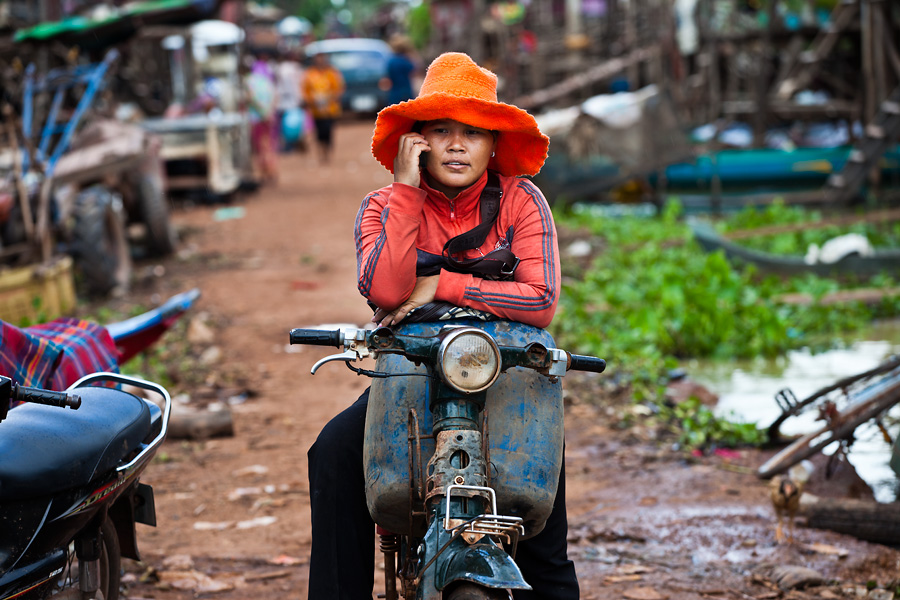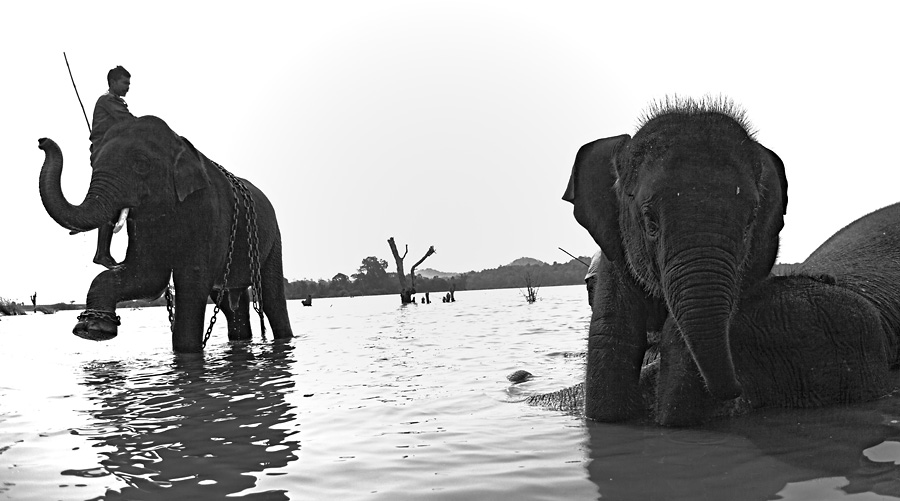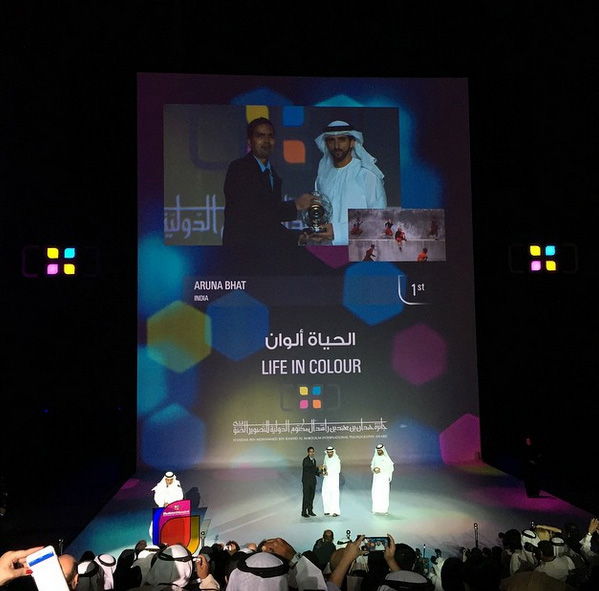This photograph was made in a small village at edge of Tonle Sap Lake. It was a sunny afternoon and I was walking with my Cambodian friend along the narrow street that connected practically every house in the village. Houses on both side of the road were built on stilts to make room for rising water levels during the high season. At some point, when the village ended and the vast expanse of Tonle Sap began, the road dipped into the water and disappeared. I was standing at the edge of water and watched the life go by. Children played, ran behind each other and splashed water on their friends. Adults went about their daily transactions – some people conversing leisurely with their neighbours, some bringing in fish for sale, some transporting goods on their motorcycles. The one common thread among all of them was the leisurely pace they did things in. No one was in a hurry, no one was anxious and no one looked like they took anything seriously. Most importantly, no one appeared to be worried about the next day and no faces showed creases on the forehead.

At some point, I turned around to look at the road I walked through, and found this charming lady in a saturated orange jacket and a hat riding towards the edge of the water. She, rather her clothes, instantly caught my attention.
Her bike was also of equal interest. The two-wheeler seemed to be counting its days and ready to disintegrate into the earth any moment. And yet, this isn’t the most ramshackle automobile I have seen in Cambodia – they ride bikes in much worse conditions, usually functioning fairly well. Honda Dream is the most popular mode of transport in the country, and perhaps the longevity promised by Japanese automobile companies plays a key role here.
For the elephants of Sakrebailu, mornings are perhaps the best time of the day. This is a time when they are taken into the river, allowed to go deep into the waters and drink their heart’s fill. Soon after, the mahout will let the elephants relax in shallow waters and scrub them for almost an hour, until they are shiny clean! These elephants are looked after well: after the swim and scrub comes the time for grub. Only thing missing there is freedom, but for which, elephants of the world would have made a beeline for an accommodation in Sakrebailu elephant camp.

I spent a few days last year observing and understanding life in the camp, when this photograph was made.
Also see: my photo essay on the elephants of Sakrebailu at JLR Explore.
It appears, Dubai is fast becoming a photography capital of the world.
The fourth season of HIPA Awards and celebration has brought the best photography crowd into the city, and it appears, this is going to continue in the years to come.
When HIPA announced the names of special prizes, I was perhaps more excited than the people at HIPA themselves. The awarded photographers – Scott Kelby and Sebastiao Salgado – were people whom I have followed online for a long time, listened to them talk on videos or have read what they have written about photography in length. While Scott Kelby has helped a great deal in the way I approach processing images and see the end product, Sebastiao Salgado has been an inspiration in thinking beyond the existing boundaries, think really big and work towards making them happen. A possibility of being able to meet them was an excitement sufficient to be in Dubai. Being part of the award ceremony was one step higher than excitement.
I did get a chance to have a brief conversation with Kelby during the award evening on the 16th. Unfortunately, Salgado wasn’t able to make it to the ceremony. But what I missed in meeting Salgado and perhaps hear him say a few things in Duabi was made up by listening to Reza Deghati, veteran photojournalist with National Geographic. Yesterday evening, Reza spoke in length about how photography can change the world and on his own endevour to improve the lives of refugees from around the world, especially middle east, through photography. His works have had remarkable effect in bringing change to suffering people. Reza spoke passionately, as he mentioned how, in one of his project, he helped reunite more than 3,000 children with their parents in Africa through photography. He stressed in working towards helping others, with a touching example of how the extended hand can often come back to you with equal empathy in the hour of need. He spoke at length about his dangerous encounters around the world as he photographed conflict, and spending time with Ahmad Shah Massoud and Yasser Arafat. His speech, as much as his works, is inspirational enough to make everyone pack their cameras and leave home!
The day before Reza’s talk, HIPA awards ceremony was a gala event that unfolded in Dubai International Financial Center on a grand stage with brilliant performances and extraordinary visuals. The grand prize winner of the 4th season was Anurag Kumar from Delhi.
It was a moment that was a mix of both pride and humbling feeling for me to receive the 1st prize in this year’s primary category – ‘Life in Colour’.

And below is the image for which the award was granted.

I would like to thank HIPA for this award, and for bringing so many amazing photographers in one platform.
In this moment, I would like to thank everyone who has contributed to my journey in photography, which is a very large set of people of various backgrounds who have touched me and helped me in a many ways, be it encouraging the journey, assisting me in the journey, being part of the journey, being mentors in person or from a distance through online medias or by becoming subjects to my camera.
It is both an honour and a privilege to be part of HIPA 4th season awards.
More information



